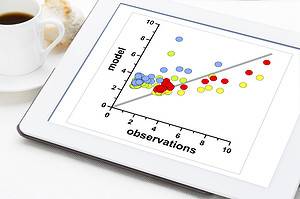Follow Me On:

Assessing Process Performance: The Value of Establishing Baselines
Updated:How do you know if your diet is working? You need to start with a baseline and then measure change from that. You should do the same for all your processes. From that process baseline, you can know whether your process is getting better, worse, or not changing. The term “process baseline” typically refers to […]
Read more
Step-by-Step Guide to Project Selection
Updated:The purpose of Lean Six Sigma is to identify opportunities for improving organizational processes. One of the challenges is the selection of projects for improvement teams to work on. Let’s learn more about how to select impactful projects. Both Lean and Six Sigma projects are used to improve organizational processes. Improvement teams are formed. DMAIC […]
Read more
Ordinal Data
Published:If you have categorical or descriptive data that has a natural order, sequence, or preference, it would be defined as ordinal data. Since ordinal data is one of four common types of data, you should understand what it is and how you can use it.
Read more
Mastering Positive Correlation Analysis: Tools and Techniques
Updated:Correlation is a statistical term of the relationship between two variables. You can have a negative correlation, positive correlation, or no correlation. Let’s see what a positive correlation is all about.
Read more
Common Non-Parametric Tests and Their Applications
Updated:Several statistical tests have underlying assumptions of a specific type of distribution which is required for the test results to be valid. But what if your data distribution does not meet that assumption? A non-parametric test might help. There are several hypothesis tests which assume your data has a specific distribution. For example, a 2-sample […]
Read more
Ordinal vs. Nominal Data: Which One Should You Choose?
Updated:When you have categorical data with a natural order or preference, you can call that ordinal data. When you describe data, you must first distinguish whether you are talking about numerical or categorical data. This is important for the proper selection and use of statistical and analytical tools. Categorical data is a type of data that […]
Read more
Making the Most of Outliers: Leveraging Insights for Improvement
Updated:An outlier in the context of statistics means a value in your data set is significantly different from the other values. This might be a good or bad thing depending on the situation.
Read more
One Piece Flow
Published:Companies love their batch flow processes. But, a one-piece flow might be a more efficient approach to producing your products. Let’s learn a bit more about one-piece flow.
Read more
Using Paired T-Tests for Controlled Analysis
Updated:A paired t-test is a form of a two-sample t-test used in hypothesis testing. It is useful for answering questions about any significant differences for before and after comparisons.
Read more
The Role of Mura in Process Waste: Strategies for Minimizing Variation
Updated:The Toyota Production System, was developed around the elimination of the three types of deviations that represent the inefficient allocation of resources. The three types of deviations are muda, mura, and muri. Muda deals with waste and is often defined by the 7 wastes of lean. Mura is concerned with inconsistency and variation and may […]
Read more
Leptokurtic Distribution
Published:Sometimes your data isn’t a normal distribution. Sometimes, the curve is taller or shorter than the normal distribution. Is that a problem? We can answer that question by learning a little bit more about kurtosis and the leptokurtic distribution.
Read more
Step-by-Step Guide to Understanding and Using Multiple Regression in Your Research
Updated:If you are trying to predict the outcome of a dependent variable by analyzing the relationship with several independent variables, then multiple regression may be your statistical tool of choice. Let’s examine multiple regression in more detail. Multiple regression is a statistical technique that allows you to analyze the relationship between a dependent variable and […]
Read more
Lean Manufacturing: Improving Quality and Reducing Costs
Updated:Lean manufacturing seeks to get rid of the extra fat and waste in your process while seeking to build muscle in your production processes. Let’s see how.
Read more
How to Optimize the Value of Hypothesis Testing
Updated:Hypothesis testing is a branch of statistics in which, using data from a sample, an inference is made about a population parameter or a population probability distribution.
Read more
Streamlining Production with Just-In-Time Manufacturing
Updated:Have you ever had to shut down your manufacturing line because major components haven’t arrived from your supplier? Have you ever had to rent extra warehouses for your finished goods? Just-in-time (JIT) manufacturing would prevent that from happening. Let’s see how that works.
Read more
Interquartile Range
Updated:In a box plot, it is easy to see the range of where 50% of your data lies. Let’s examine this a little further by describing the interquartile range. Quartiles can be defined as dividing your data into 4 parts or quarters of approximately equal size. You can define the 4 parts in terms of […]
Read more
Meeting Customer Expectations with Kano Analysis
Updated:What do your customers really want? You are taking a risk by blindly fulfilling your customers’ needs without understanding how they classify them. Kano analysis will allow you to properly classify those customer needs and lower your risk.
Read more
The Concept of Kaizen: The Key to Continuous Improvement
Updated:If your organization is too impatient to use a formal DMAIC approach to continuous improvement then Kaizen may be the tool for you.
Read more
Maximizing the Benefits of In-Control: Tips for Process Improvement
Updated:In-control is not referring to the behavior of your children. It’s about whether your process is exhibiting common or special cause variation. Let’s explore how this works.
Read more
Track Organizational Progress with the Help of Key Performance Indicators
Updated:How does your organization track and monitor organizational performance? Do you have key metrics that you frequently look at to make decisions? Using Key Performance Indicators (KPIs) is a common method for tracking your most important metrics. Let’s see how. A Key Performance Indicator (KPI) is a measurable value that demonstrates how effectively a company […]
Read more
Hoshin Kanri
Published:Does your organization just focus on today’s operational and tactical issues, or is there a process for developing a strategic plan for the future? Hoshin Kanri is a method for ensuring an organization’s strategic goals drive progress and action at every level within that organization.
Read more
The Competitive Advantage of Being a Certified Green Belt
Updated:Will having a Lean Six Sigma Green Belt help you break boards? No. But a trained and experienced Green Belt will help improve what your organization does so you can defeat waste, process defects, and much more. Let’s see how.
Read more
The Evolution and Impact of Jidoka
Updated:STOP THE PRESSES! Jidoka will immediately stop equipment upon discovering an abnormality in the process. Let’s explore this a little deeper.
Read more